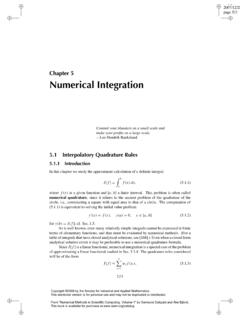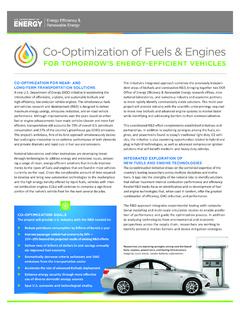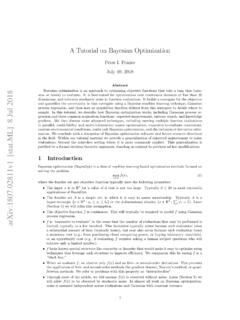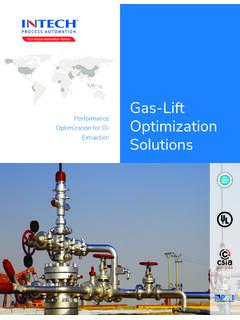Transcription of Chapter 1 Introduction to Process Optimization
1 Book_tem2010/7/27page 1 Chapter 1 Introduction to ProcessOptimizationMost things can be improved, so engineers and scientists optimize. While designing systemsand products requires a deep understanding of influences that achieve desirable performance,the need for anefficient and systematic decision-making approachdrives the need for opti-mization strategies. This introductory Chapter provides the motivation for this topic as wellas a description of applications in chemical engineering. Optimization applications can befound in almost all areas of engineering.
2 Typical problems in chemical engineering arise inprocess design, Process control, model development, Process identification, and real-timeoptimization. The Chapter provides an overall description of Optimization problem classeswith a focus on problems with continuous variables. It then describes where these problemsarise in chemical engineering, along with illustrative examples. This Introduction sets thestage for the development of Optimization methods in the subsequent Scope of Optimization ProblemsFrom a practical standpoint, we define theoptimizationtask as follows: given a systemor Process , find the best solution to this Process within constraints.
3 This task requires thefollowing elements: Anobjective functionis needed that provides a scalar quantitative performance mea-sure that needs to be minimized or maximized. This can be the system s cost, yield,profit, etc. A predictive model is required that describes the behavior of the system. For theoptimization problem this translates into a set of equations and inequalities that wetermconstraints. These constraints comprise a feasible region that defines limits ofperformance for the system. Variablesthat appear in the predictive model must be adjusted to satisfy the con-straints.
4 This can usually be accomplished with multiple instances of variable values,leading to a feasible region that is determined by a subspace of these variables. Inmany engineering problems, this subspace can be characterized by a set ofdecisionvariablesthat can be interpreted asdegrees of freedomin the 2 2 Chapter 1. Introduction to Process OptimizationOptimization is a fundamental and frequently applied task for most engineering ac-tivities. However, in many cases, this task is done by trial and error (through case study). Toavoid such tedious activities, we take a systematic approach to this task, which is as efficientas possible and also provides some guarantee that a better solution cannot be systematic determination of optimal solutions leads to a large family of methodsand algorithms.
5 Moreover, the literature for Optimization is dynamic, with hundreds ofpapers published every month in dozens of journals. Moreover, research in optimizationcan be observed at a number of different levels that necessarily need to overlap but are oftenconsidered by separate communities: At themathematical programming1level, research focuses on understanding fun-damental properties of Optimization problems and algorithms. Key issues includeexistence of solutions, convergence of algorithms, and related issues such as stabilityand convergence rates.
6 Thescientific computinglevel is strongly influenced by mathematical properties aswell as the implementation of the Optimization method for efficient and practical research questions include numerical stability, ill-conditioning of algorithmicsteps, and computational complexity and performance. At the level ofoperations research, attention is focused on formulation of the optimi-zation problem and development of solution strategies, often by using well-establishedsolution methods. Many of the problems encountered at this level consider well-structured models with linear and discrete elements.
7 At theengineeringlevel, Optimization strategies are applied to challenging, and of-ten poorly defined, real-world problems. Knowledge of Optimization at this level isengaged with the efficiency and reliability of applicable methods, analysis of the so-lution, and diagnosis and recovery from failure of the solution the above description of Optimization research, it is clear that successful devel-opment of an Optimization strategy within a given level requires a working knowledge ofthe preceding levels. For instance, while it is important at the mathematical programminglevel to develop the right optimizationalgorithm, at the engineering level it is even moreimportant to solve the right optimizationproblem formulation.
8 On the other hand, as en-gineers need to consider Optimization tasks on a regular basis, a systematic approach with afundamental knowledge of Optimization formulations and algorithms is essential. It shouldbe noted that this requires not only knowledge of existing software, which may have limitedapplication to particularly difficult problems, but also knowledge of the underlying algo-rithmic principles that allow challenging applications to be addressed. In the next sectionwe begin with a classification of mathematical programming problems.
9 This is followed byexamples of Optimization problems in chemical engineering that will be addressed in thistext. Finally, a simple example is presented to motivate the development of optimizationmethods in subsequent termmathematical programmingwas coined in the 1940s and is somewhat unrelated to computerprogramming; it originally referred to the more general concept of Optimization in the sense of 3 Classification of Optimization Classification of Optimization ProblemsOptimization is a key enabling tool for decision making in chemical engineering.
10 It hasevolved from a methodology of academic interest into a technology that continues to sig-nificant impact in engineering research and practice. Optimization algorithms form the coretools for (a) experimental design, parameter estimation, model development, and statisticalanalysis; (b) Process synthesis, analysis, design, and retrofit; (c) model predictive controland real-time Optimization ; and (d) planning, scheduling, and the integration of processoperations into the supply chain for manufacturing and shown in Figure , Optimization problems that arise in chemical engineering canbe classified in terms of continuous and discrete variables.









